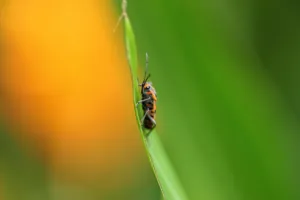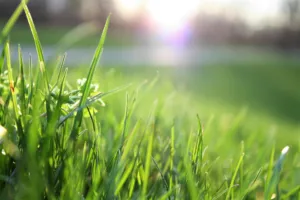Learn How to Detect the Damage & Fight Back Effectively
Your lawn might look lush and green at first glance, but don’t be fooled. A hidden pest may be quietly turning your turf into a battleground. Chinch bugs, though small in size, can cause major destruction in Alabama before you even realize they’re there.
These pests are among the most damaging insects for Alabama lawns, particularly those with St. Augustine grass.
They feed by draining sap from grass blades and injecting toxic saliva that disrupts the plant’s ability to absorb water, quickly resulting in large, discolored patches.

Noticed yellowing grass that isn’t bouncing back after watering? Southern chinch bugs could be the cause. Below, we’ll explore:
- What chinch bugs look like
- How to recognize the damage they cause
- Smart prevention strategies
- Ways to treat an active infestation
What Exactly Are Chinch Bugs?
Though tiny, chinch bugs are seriously menacing. Typically no bigger than a grain of rice, their small size makes them tough to spot unless you know just what to look for.
They harm lawns by feeding on the sap inside grass blades, simultaneously releasing a toxin that stops the grass from absorbing moisture. This combo leads to fast-spreading lawn damage that worsens over time.
Key Details About Alabama Chinch Bugs:
- Size: Adults are about 1/5-inch long.
- Color: Black bodies with white wings folded over their backs.
- Nymphs: Start pink or red with a white stripe before maturing.
- Lifecycle: A single female can lay over 200 eggs per season (beginning in spring).
- Peak Activity: They come out in April, and most damage happens May through August.
Chinch bugs thrive in Alabama’s hot, sunny weather. While well-maintained, hydrated lawns are less appealing to them. Unfortunately, no yard is completely immune though.
Is Your Lawn Being Attacked?
Because chinch bug damage often looks like drought symptoms or disease, spotting them early can be tricky. Here’s what to watch for:
Irregular Yellow or Brown Spots
Dead patches often begin near pavement or in sun-drenched areas. The grass may start yellowing before turning brown and brittle.
Grass Doesn’t Respond to Water
Drought-affected turf usually looks better after a deep soak. But grass damaged by chinch bugs remains brown and limp, no matter how much water it gets.
Use the Tin Can Test
Cut the ends off a can (soup or coffee cans work best), press it into the soil near a damaged area, and fill it with water. Wait 10 minutes. If chinch bugs are present, they’ll rise to the surface.
Unpleasant Odor
Notice a strange, musty smell while walking across the lawn? Chinch bugs release a foul scent, which becomes stronger when they’re crushed underfoot.
Inspect the Thatch Layer
Pull apart the grass near dead zones and peer into the thatch. You may spot tiny, fast-moving bugs. Try using a magnifying glass if you have one.

How Can I Prevent Chinch Bugs?
As with most warm-season grass issues, prevention is your first line of defense. Use these tips to discourage chinch bug infestations in Robertsdale, AL:
Healthy Lawn Habits
- Mow High: Keep grass at 3–4 inches to promote deep roots.
- Water Deeply: Aim for 1–1.5 inches per week. Early morning is often the best time.
- Dethatch Regularly: Thatch over 0.5 inches thick attracts chinch bugs.
- Avoid Over-Fertilizing: Too much nitrogen makes grass a pest magnet.
Also, you should avoid these three common mistakes that many Alabama homeowners make:
- Overwatering. Sometimes, more water isn’t the way to go. For instance, too much H2O can actually hurt your yard, creating fungal issues.
- Cutting your lawn too short. Scalping your grass weakens it. The negative impact is that it’s easier for pests and diseases to take hold.
- Using broad-spectrum insecticides. This will harm helpful insects (ladybugs, lacewings, and ground beetles) that eat chinch bugs.
How Do I Get Rid of Southern Chinch Bugs?
Okay, so chinch bugs are present. What should you do now? Fast action is essential since they reproduce rapidly.
Eco-Conscious Lawn Service Options:
- Neem Oil: Interrupts the bug’s life cycle. Apply early morning or late evening.
- Insecticidal Soap: Great for nymphs, but must directly contact them.
- Diatomaceous Earth: A safe, powdery substance that kills chinch bugs by drying them out.
Chemical Control:
Apply insecticides with bifenthrin or cyfluthrin in the morning when chinch bugs are most active. Follow label instructions carefully to protect pollinators and helpful insects.
Call in the Professionals at TDI Services
If you’re dealing with a large infestation in your southern yard, your best bet is a professional lawn care company like TDI Services. Our experts can:
- Accurately determine the scope of the infestation
- Apply targeted treatments for exceptional results
- Provide long-term prevention plans that work
Want to make sure you win the battle against dandelions? Contact your local lawn care and pest control services in Robertsdale, AL at TDI Services. With highly trained technicians and industry-leading products, we’ll take steps to help achieve your dream yard.
Defend Your Lawn This Season!
Chinch bugs may be tiny, but the damage they cause is far from small. With early detection and the right treatment, you can protect your lawn and restore its health.
If you think chinch bugs are destroying your grass, don’t wait. Contact the local, neighbor-recommended experts at TDI Services today! We’ll create a customized treatment plan to eliminate any lawn pests and give you the picture-perfect yard you’ve dreamed about.
